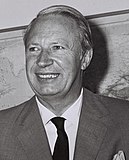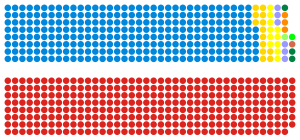October 1974 United Kingdom general election|
|
|
|
| Turnout | 72.8%,  6.0% 6.0% |
|---|
|
|
First party
|
Second party
|
|
|
![]()
|

|
| Leader
|
Harold Wilson
|
Edward Heath
|
| Party
|
Labour
|
Conservative
|
| Leader's seat
|
Huyton
|
Sidcup
|
| Last election
|
301 seats, 37.2%
|
297 seats, 37.9%
|
| Seats won
|
319
|
277
|
| Seat change
|
 18 18
|
 20 20
|
| Popular vote
|
11,457,079
|
10,462,565
|
| Percentage
|
39.2%
|
35.8%
|
| Swing
|
 2.0% 2.0%
|
 2.1% 2.1%
|
|
|
|
Third party
|
Fourth party
|
|
|
|
|
| Leader
|
Jeremy Thorpe
|
William Wolfe
|
| Party
|
Liberal
|
SNP
|
| Leader's seat
|
North Devon
|
Stood in West Lothian (lost)
|
| Last election
|
14 seats, 19.3%
|
7 seats, 2.0%
|
| Seats won
|
13
|
11
|
| Seat change
|
 1 1
|
 4 4
|
| Popular vote
|
5,346,704
|
839,617
|
| Percentage
|
18.3%
|
2.9%
|
| Swing
|
 1.0% 1.0%
|
 0.9% 0.9%
|
|
 Colours show the winning party—as shown in § Results |
 |
|
A general election was held on the 10 October 1974 to elect all 635 members of the House of Commons of the United Kingdom. The Labour Party won the election with a very small majority of 3 seats and Harold Wilson stayed as Prime Minister.
This was the second general election to happen in 1974. The last election in February ended in a hung parliament and no parties wanted to start a coalition government. This meant Labour had to start a minority government. This is why a second election was held, because governments are very hard to run if they do not have a majority.[1][2]
References